
1757 (MDCCLVII) was a common year starting on Saturday of the Gregorian calendar and a common year starting on Wednesday of the Julian calendar, the 1757th year of the Common Era (CE) and Anno Domini (AD) designations, the 757th year of the 2nd millennium, the 57th year of the 18th century, and the 8th year of the 1750s decade. As of the start of 1757, the Gregorian calendar was 11 days ahead of the Julian calendar, which remained in localized use until 1923.

The Battle of Leipzig, also known as the Battle of the Nations, was fought from 16 to 19 October 1813 at Leipzig, Saxony. The Coalition armies of Austria, Prussia, Sweden, and Russia, led by Tsar Alexander I and Karl von Schwarzenberg, decisively defeated the Grande Armée of French Emperor Napoleon Bonaparte. Napoleon's army also contained Polish and Italian troops, as well as Germans from the Confederation of the Rhine. The battle was the culmination of the German Campaign of 1813 and involved 560,000 soldiers, 2,200 artillery pieces, the expenditure of 400,000 rounds of artillery ammunition, and 133,000 casualties, making it the largest battle of the Napoleonic Wars, and the largest battle in Europe prior to World War I.

The Pomeranian War was a theatre of the Seven Years' War. The term is used to describe the fighting between Sweden and Prussia between 1757 and 1762 in Swedish Pomerania, Prussian Pomerania, northern Brandenburg and eastern Mecklenburg-Schwerin.
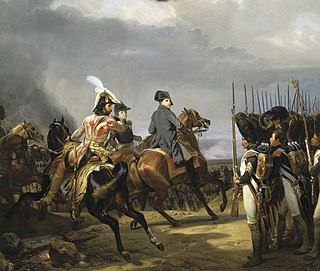
The twin battles of Jena and Auerstedt were fought on 14 October 1806 on the plateau west of the river Saale in today's Germany, between the forces of Napoleon I of France and Frederick William III of Prussia. The defeat suffered by the Prussian Army subjugated the Kingdom of Prussia to the French Empire until the Sixth Coalition was formed in 1813.

In the War of the Sixth Coalition, sometimes known in Germany as the Wars of Liberation, a coalition of Austria, Prussia, Russia, Spain, Great Britain, Portugal, Sweden, Sardinia, and a number of German States defeated France and drove Napoleon into exile on Elba. After the disastrous French invasion of Russia of 1812 in which they had been forced to support France, Prussia and Austria joined Russia, the United Kingdom, Sweden, and Portugal, and the rebels in Spain who were already at war with France.

The Battle of Kolín (Kolin) on 18 June 1757 saw 54,000 Austrians under Count von Daun defeat 34,000 Prussians under Frederick the Great during the Third Silesian War. Prussian attempts to turn the Austrian right flank turned into piecemeal frontal attacks and were defeated in five and a half hours of combat. The Prussians lost 13,733 men, the Austrians 8,100. Frederick gave up the siege of Prague as well as his planned march on Vienna and retreated to Saxony.
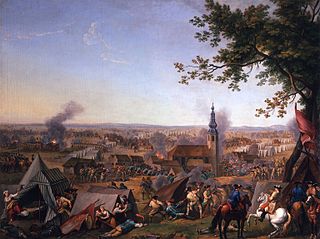
The Battle of Hochkirch took place on 14 October 1758, during the Third Silesian War. After several weeks of maneuvering for position, an Austrian army of 80,000 commanded by Lieutenant Field Marshal Leopold Josef Graf Daun surprised the Prussian army of 30,000–36,000 commanded by Frederick the Great. The Austrian army overwhelmed the Prussians and forced a general retreat. The battle took place in and around the village of Hochkirch, 9 kilometers (6 mi) east of Bautzen, Saxony.

The Battle of Maxen was a battle at Maxen, in the Electorate of Saxony during the Third Silesian War. It resulted in surrender of a Prussian corps.

The Royal Prussian Army served as the army of the Kingdom of Prussia. It became vital to the development of Prussia as a European power.
During the Seven Years' War, the Prussian-held town of Kolberg in Brandenburg-Prussian Pomerania was besieged by Russian forces three times. The first two sieges, in late 1758 and from 26 August to 18 September 1760, were unsuccessful. A final and successful siege took place from August to December 1761. In the sieges of 1760 and 1761, the Russian forces were supported by Swedish auxiliaries.

The Seven Years' War (1756–1763) was a global conflict involving most of the European great powers, fought primarily in Europe and the Americas. The opposing alliances were led by Great Britain, primarily supported by Prussia, and France, backed by Spain, Saxony, Sweden, and Russia. Related conflicts include the 1754 to 1763 French and Indian War, and 1762 to 1763 Anglo-Spanish War.

The Third Silesian War was a war between Prussia and Austria that lasted from 1756 to 1763 and confirmed Prussia's control of the region of Silesia. The war was fought mainly in Silesia, Bohemia and Upper Saxony and formed one theatre of the Seven Years' War. It was the last of three Silesian Wars fought between Frederick the Great's Prussia and Maria Theresa's Austria in the mid-18th century, all three of which ended in Prussian control of Silesia.

The Battle of Luckau was fought at Luckau in Brandenburg on 4 June 1813 during the War of the Sixth Coalition. Prussian and Russian forces under General Friedrich Wilhelm von Bülow defeated part of a French-Allied corps under Marshal Nicolas Oudinot.
The Blockade of Stralsund occurred during the Seven Years' War when a Prussian force invested the Swedish garrison of Stralsund, the capital of Swedish Pomerania. Rather than lay formal siege to the port, the Prussians cut it off by land and blockaded it. They were unable to cut it off by sea, owing to a lack of a Prussian fleet, and eventually the blockade was abandoned when the bulk of Prussian forces were withdrawn to fight in other theatres.

The 1757 raid on Berlin took place during the Third Silesian War. Cavalrymen of the Holy Roman Empire attacked and briefly occupied Berlin, the capital of Prussia.

The Capitulation of Pasewalk on 29 October 1806 resulted in the surrender of Oberst (Colonel) von Hagen's 4,200 Prussian soldiers to an inferior force of two French light cavalry brigades led by Generals of Brigade Édouard Jean Baptiste Milhaud and Antoine Lasalle. The Prussians were completely demoralized after a two-week-long retreat following their decisive defeat at the Battle of Jena-Auerstedt. Pasewalk is 110 kilometers north of Berlin and about 40 kilometers west of Szczecin (Stettin), Poland.
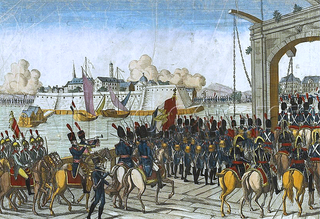
In the Capitulation of Stettin on 29–30 October 1806, Lieutenant General Friedrich Gisbert Wilhelm von Romberg surrendered the garrison and fortress to a much smaller French light cavalry brigade led by General of Brigade Antoine Lasalle. This event was one of a number of surrenders by demoralized Prussian soldiers to equal or inferior French forces after their disastrous defeat at the Battle of Jena-Auerstedt on 14 October. Stettin, now Szczecin, Poland, is a port city on the Oder River near the Baltic Sea, about 120 kilometres (75 mi) northeast of Berlin.
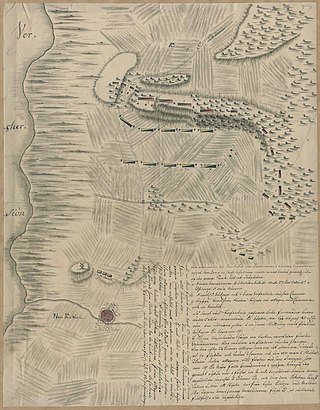
The Battle of Neukalen was a battle at Neukalen of the Seven Years' War between Swedish and Prussian forces fought on 2 January 1762. The Swedish force under the command of Carl Constantin De Carnall managed to rout the Prussian forces under Wilhelm Sebastian von Belling positioned on a hill next to the town of Malchin. This was the last battle of the Swedish and Prussian troops during the war. The Swedes had a total of 4,000 men, in eight 8 battalions and several hundred cavalry. However, only the first line of 2,000 infantry and 200 cavalry took part in the fighting. The Prussian force consisted of more than 2,000 men, in 5 battalions, 2 companies and a hussar regiment. The Swedes had 37 killed and 137 wounded, while the Prussians had 50 killed, 120 wounded, and 180 captured.

The Battle of Neuensund was a smaller battle at Neuensund of the Seven Years' War between Swedish and Prussian forces fought on September 18, 1761. The Swedish force under the command of Jacob Magnus Sprengtporten managed to rout the Prussian forces commanded by Wilhelm Sebastian von Belling.
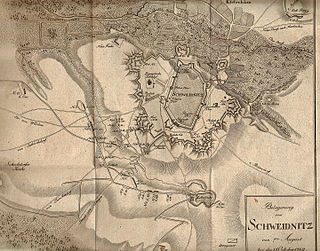
The siege of Schweidnitz took place between August and October 1762 during the Third Silesian War, part of the wider Seven Years' War. Prussian forces under the overall command of Frederick II laid siege to the city of Schweidnitz, in an attempt to retake it from an Austrian garrison.


















